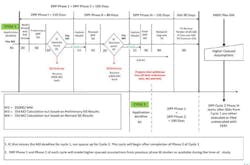MISO’s Generator Interconnection Procedures are changing (again). In the tradition of New Year’s resolutions, MISO proposed Tariff changes on New Year’s Eve 2015, resolving to improve its interconnection process in 2016 (Docket No. ER16-675). This filing marks MISO’s fourth set of revisions since 2008, and, like all New Year’s resolutions, only time will tell whether good intentions lead to lasting improvements. Comments on MISO’s proposal were due by Jan. 29, 2016.
Five main resolutions from MISO’s latest proposal follow:
1. Slim down in 2016.
MISO will subdivide its study process and add “off-ramps” to reduce the number of projects being studied and to give projects more flexibility to exit and more certainty if they proceed. MISO’s new study process seeks to minimize cascading restudies caused by project withdrawals by subdividing the Definitive Planning Phase (DPP), the phase where Interconnection Studies occur, into three parts and providing two “off-ramps” to exit the study process with some milestone payments refunded.
To reduce the chronic study delays caused by the withdrawal of higher-queued projects that trigger “cascading restudies” for lower-queued projects, MISO would divide its DPP into three phases (I-III). Aliff Testimony at 16 & Attach. A. Each DPP Phase will provide an incrementally more accurate System Impact Study (SIS): (i) a preliminary SIS in DPP Phase I, (ii) a revised SIS in DPP Phase II, and (iii) a final SIS in DPP Phase III. Id. To increase certainty in each phase, MISO’s process would encourage withdrawals at two defined “off-ramps” (Decision Points I and II) at the end of DPP Phases I and II. Id. at 17. By integrating ongoing restudy after these Decision Points, MISO hopes to increase certainty as it reduces the number of projects in the queue. MISO’s Facility Studies will follow the final SIS in DPP Phase III, after which MISO will tender a draft pro forma GIA to each project. Id. at 21.
MISO’s three DPP Phases are also intended to eliminate the “overlap” of studies because MISO will not start a new study “cycle” until one cycle of DPP Phases I-III is complete. Id. at 21-22. For example, MISO would begin DPP Phase III of Cycle 2 only after all projects in Cycle 1 have i) executed GIAs, ii) requested MISO to file the unexecuted GIA with FERC, or iii) withdrawn their project and MISO has determined no restudy was required.
MISO’s filing graphically displays its process as follows
2. Meet your deadlines.
Milestone payments provide deadlines and refund incentives to exit at “off-ramps.” As an incentive to use the new Decision Point I and II off-ramps, MISO will add new milestone payments and will make two milestones (the existing M2 milestone and a new M3 milestone) refundable if a project uses an off-ramp. MISO will retain the M2 Milestone but will modify its timing and calculation (see Resolution 3 below). See Aliff Testimony at 27 & Attach. A. The new milestones, M3 and M4, will be required before a project can enter the last two DPP Phases. Therefore, a project will make a milestone payment to enter each DPP Phase: the M2 Milestone to enter DPP Phase I, the M3 Milestone to enter DPP Phase II, and the M4 Milestone to enter DPP Phase III. The new M3 and M4 milestones will be calculated using the formula currently used for the M2 milestone, which accounts for the interconnecting zone’s schedule 7 $/MW year long-term firm point-to-point transmission service rate, the MW size of the facility, and the number and cost of constraints. See id. at 29-30; Proposed GIP secs. 7.3.1.4.1 and 7.3.2.4.1. MISO would provide a 100 percent refund of the prior Milestone Payment as an incentive for the project to withdraw at two off-ramps after Phases I and II. Id. at 17 & Attach. A.
With the M2 and M3 milestone refunds providing an incentive, MISO anticipates that these off-ramp deadlines will encourage unready projects to exit the process earlier, thereby increasing the certainty for projects that remain. Assuming that projects withdraw earlier, each DPP phase will give the remaining projects increasingly better information to help them decide whether to continue or to withdraw at the next deadline. See id. at 22.
3. Set up an easy payment plan.
ISO would change the amount and timing of the M2 milestone. MISO proposes replacing the current M2 formula calculation with a flat fee of $5,000 per MW of new gross nameplate capacity, based on the rationale that it reflects the average M2 amount collected across all projects, regardless of size, since the implementation of the M2 milestone in 2012. Id. at 27. MISO found that the M2 milestone has not served a deterrent purpose, since projects remain in the queue as long as possible because the milestone was only refundable if MISO found no harm to lower-queued projects. Id. at 26. MISO’s proposal would also move the due date for the M2 Milestone payment up by 15 Calendar Days, from 30 Calendar Days prior to the commencement of the DPP cycle to 45 Calendar Days before DPP Phase I. MISO notes that the 45 Calendar Day deadline coincides with the date when all materials for an Interconnection Request to enter the DPP are due. Id. at 27.
4. Be more self-assured.
Restudy of a project with a GIA will require a FERC order. In response to concerns with ongoing risk of restudy, MISO would eliminate seven of the eight restudy triggers in Article 11.3.1 of the pro forma GIA, and would allow restudies ordered by FERC only in order to break the link between higher-queued assumptions and lower-queued projects and end cascading restudies. The pro forma GIA currently lists eight conditions under which a project consents to restudy, many of which involve actions of higher-queued projects, such as withdrawals and GIA terminations. Under the revised GIP, once a DPP cycle ends and all projects in that cycle execute a GIA or direct MISO to file an unexecuted GIA with FERC, a restudy may be triggered only when so ordered by the Commission. MISO states that it would not address these changes in GIAs already executed, but would “recognize and account for changes to the Transmission System in future cycles to provide as great a certainty to the projects that have executed a GIA.” Id. at 25.
5. Plan for new opportunities.
Transition of existing projects to the new GIP will depend on where they are in the current process as of the granted effective date. MISO requested a March 30, 2016 effective date for its GIP revisions and proposes to have the changes apply differently to projects, depending on where they are in the current GIP process as of the effective date ultimately granted by FERC. In fine New Year’s tradition, MISO’s filing provides a “who’s in and who’s out” list for projects in 2016:
OUT: Not subject to the new GIP process are:
- Projects that (1) have already executed a non-provisional GIA or (2) have requested that MISO file a non-provisional GIA unexecuted by the effective date of the new process [requested for 3/30/16]. A non-provisional GIA is one that is not subject to conditions, in contrast to a “provisional GIA,” which a project may request prior to the completion of required Network Upgrades but which is subject to possible operating limitations or other conditions. See GIP, Sec. 11.5, now in proposed GIP, Sec. 7.9.
- Projects that either (1) have GIA negotiations ongoing or (2) have a completed Network Upgrade Facilities Study for a project by the requested effective date of the new proposed Tariff revisions will not be subject to the new requirements for that project.
IN: The new GIP would apply to all other projects, but would provide different options for projects at different points in the process:
Projects with Network Upgrade Facilities Studies ongoing at the time of the effective date: These projects will continue on their path to a GIA, but MISO would complete the GIA negotiations in 90 Calendar Days after the Facilities Study is complete under the new, shortened time frame.
Projects with Interconnection System Impact Studies ongoing at the time of the effective date: These projects will be placed in the Decision Point II of “Cycle 1.” These projects then face a fork in the road through the GIP on their way to a GIA.
- The first path would allow the project to proceed to DPP Phase III if it pays the newly proposed M4 Milestone payment. Because these projects have moved directly to Decision Point II and skip Decision Point I, they would not pay the M3 Milestone.
- The second path would allow the Interconnection Customer not to proceed through Cycle 1 but allow it to be combined with “Cycle 2” projects (beginning in fall of 2016), which would be considered lower-queued to DPP Cycle 1 projects. If Interconnection Customers use the second path, then the Interconnection Customers would be required to pay M3 and M4 during Decision Points I and II, consistent with the new Tariff provisions.
Under both paths, MISO is not requiring Interconnection Customers to pay the M2 milestone, as all existing Interconnection Customers have already paid the M2 milestone under the current process. MISO will accept the already paid M2, as calculated under the current process, as the M2 Milestone payment and will not require this M2 to be trued up to the new calculation of M2.
Projects that do not fall into one of the above categories
These projects will be required to pay the M2 milestone and proceed under the new procedures if they have a new request in 2016, or do not have an Interconnection System Impact Study started as of March 30, 2016, with respect to their pending project.
As with every New Year, the only constant is change. MISO’s resolutions to revise the GIP will bring change in 2016, but uncertainties remain. After considering any comments filed by January 29, FERC will review MISO’s proposal under the “independent entity” standard of review to see if it is consistent with FERC’s Order No. 2003. This standard allows for variation to meet MISO’s regional needs and will likely permit approval of many of MISO’s proposed revisions.
However, with change comes opportunity. Stakeholders may raise legitimate questions about the new timing and payments by acting promptly and may influence change for the better in the future and for their existing projects. The new process provides opportunity for interested parties to gain access to better information and use it to further advance ready projects. Existing projects will also need to move quickly to determine how they will be impacted by the transition.
But even MISO’s proposal does not mark the end of possible change to the GIP this year. A rulemaking petition by AWEA is pending at FERC and requests nationwide changes to the queue process of all regulated public utilities (Docket No. RM15-21). MISO would have to adapt its GIP further or demonstrate that it has already met any requirements promulgated in that docket. In a world of constant change, interested parties should make their own resolutions to stay informed and participate, to be a part of the change, rather than risk being left out in 2016.
[1] The chart is in Attachment A to the Testimony of Timothy Aliff (Tab A of MISO’s 12/31/15 filing in Docket No. ER16-675), available on MISO’s website:
Venable LLP Energy attorney Michael Splete practices regulatory law with a focus on matters related to energy and the federal and state regulation of electricity, natural gas, and oil pipelines. His work on Regional Transmission Organization ("RTO") operations includes electric generator interconnection, transmission cost allocation, electricity markets, and compliance with North American Electric Reliability Corporation ("NERC") Reliability Standards to ensure reliable operation of the electric power grid and protect critical physical and cyber infrastructure.
Venable LLP Energy Partner David M. DeSalle advises clients on a variety of transactional and regulatory issues and representing them before state and federal courts and regulatory agencies. Mr. DeSalle has worked extensively for the Midcontinent Independent System Operator, Inc. (MISO), a regional transmission organization that provides open-access transmission service and monitors the high voltage transmission system throughout the central United States and Manitoba, Canada, and operates one of the world's largest real-time energy markets. Mr. DeSalle has assisted the MISO in the long and complex regulatory processes that have led to the establishment of its energy markets and implementation of additional services that support reliable transmission service.
Venable LLP Energy Partner Brian Zimmet has a broad range of experience in federal regulation and restructuring of the electric utility industry.In recent years, Mr. Zimmet’s practice has focused on the regulation of reliability matters by the Federal Energy Regulatory Commission (FERC), the North American Electric Reliability Corporation (NERC), and Regional Entities pursuant to FPA Section 215. Mr. Zimmet was also the primary drafter of the Retail Electric Competition and Consumer Protection Act of 1999 which is Washington, DC’s electric retail access legislation.



